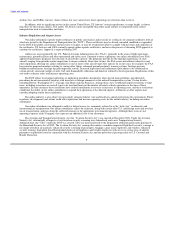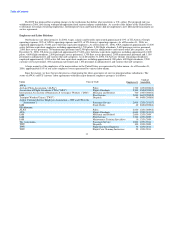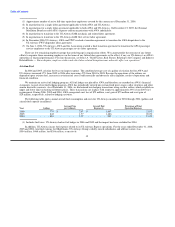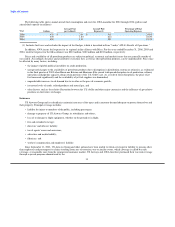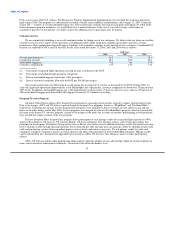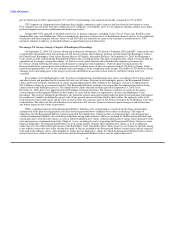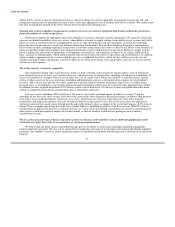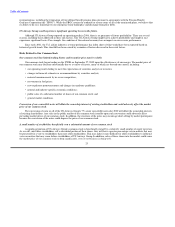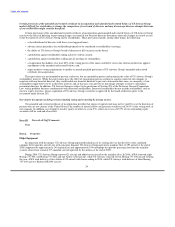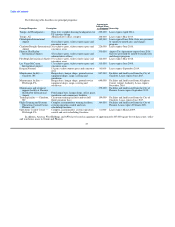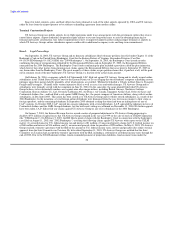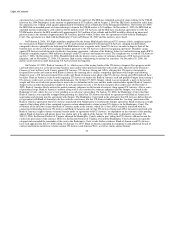US Airways 2006 Annual Report Download - page 22
Download and view the complete annual report
Please find page 22 of the 2006 US Airways annual report below. You can navigate through the pages in the report by either clicking on the pages listed below, or by using the keyword search tool below to find specific information within the annual report.
Table of Contents
The integration of US Airways Group and America West Holdings following the merger continues to present significant challenges.
US Airways Group and America West Holdings face significant challenges in consolidating functions and integrating their
organizations, procedures and operations in a timely and efficient manner. The integration of US Airways Group and America West
Holdings has been and will continue to be costly, complex and time consuming, and management will continue to devote substantial
effort to that integration and may have its attention diverted from ongoing operational matters or other strategic opportunities.
The inability to maintain labor costs at competitive levels could harm our financial performance.
Our business plan includes assumptions about labor costs going forward. Currently, the labor costs of both AWA and US Airways
are very competitive and very similar; however, we cannot assure you that labor costs going forward will remain competitive, because
our agreements may become amendable, because competitors may significantly reduce their labor costs or because we may agree to
higher-cost provisions in our current labor negotiations. Approximately 81% of the employees within US Airways Group are represented
for collective bargaining purposes by labor unions. In the United States, these employees are organized into nine labor groups represented
by five different unions at US Airways, ten labor groups represented by five different unions at AWA, four labor groups represented by
four different unions at Piedmont, and four labor groups represented by four different unions at PSA. In January 2007, two unions filed
applications with the National Mediation Board to represent two additional labor groups at PSA, the dispatchers and the stock clerks.
There are additional unionized groups of US Airways employees abroad.
Some of our unions have brought grievance arbitrations in the context of the labor integration process. Unions may bring additional
court actions or grievance arbitrations and may seek to compel us to engage in the bargaining processes where we believe we have no
such obligation. If successful, there is a risk these judicial or arbitral avenues in the context of the merger could create additional costs
that we did not anticipate.
Our future growth is dependent on obtaining adequate operating facilities at airports throughout our network.
In order to add new service and grow our presence in key airports and markets, or start service to new destinations, we must be able
to obtain adequate gates, ticketing facilities, operations areas, slots (where applicable) and office space. For example, at our largest hub
airport, we are seeking to increase international service despite challenging airport space constraints. Also, as airports around the world
become more congested, we cannot always be sure that our plans for new service can be implemented in a commercially viable manner
given operating constraints at airports throughout our network.
The travel industry continues to face ongoing security concerns.
The attacks of September 11, 2001 and continuing terrorist threats materially impacted and continue to impact air travel. The
Aviation Security Act mandates improved flight deck security; deployment of federal air marshals on board flights; improved airport
perimeter access security; airline crew security training; enhanced security screening of passengers, baggage, cargo, mail, employees and
vendors; enhanced training and qualifications of security screening personnel; additional provision of passenger data to U.S. Customs and
enhanced background checks. These increased security procedures introduced at airports since the attacks have increased costs to airlines.
A concurrent increase in airport security charges and procedures, such as restrictions on carry-on baggage, has also had a disproportionate
impact on short-haul travel, which constitutes a significant portion of US Airways' flying and revenue. We would also be materially
impacted in the event of further terrorist attacks or perceived terrorist threats.
Delays in scheduled aircraft deliveries or other loss of anticipated fleet capacity may adversely impact our operations and financial
results.
The success of our business depends on, among other things, the ability to operate a certain number and type of aircraft. In many
cases, the aircraft we intend to operate are not yet in our fleet, but we have contractual
19


